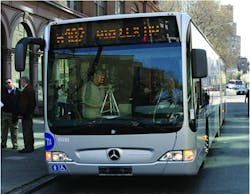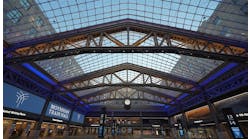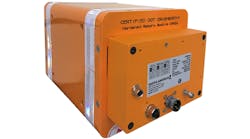Commuters, whether in the station or on board, have to respond to announcements quickly and with confidence. However, the transit environment places demands on people’s hearing not found in controlled environments such as theaters, concert halls, even cars. Those demands include sounds such as excited children, traffic noise, passenger conversation and loud music, as well as visual chaos, such as passengers moving back and forth. Even strong scents and odors can be a distraction. Add in that transit companies want to attract riders over 50, who are many times hard of hearing, and it becomes easy to see why transit designers are demanding more of loudspeakers.
An Evolution in Mass Transit Speakers
Loudspeakers are the key element in any sound system. They must be chosen carefully and specifically for the transit industry. Not too many years ago, speakers used for mass transit applications were not specifically designed for the industry. Sometimes speakers weren’t even designed for mass transit’s standard 70-volt systems.
At other times, 4-ohm automobile speakers, which consume twice the power, were used. Although great for music, car speakers have the wrong frequency response and sensitivity to deliver clear, strong announcements efficiently. And almost always, assembly of automotive speakers and enclosures created additional labor costs and altered the sound quality.
Today a new generation of speakers is available. This new generation addresses industry needs, such as better sound, improved clarity, and easier and less expensive installation.
New mass transit speakers come complete with transformer, ceiling grill and enclosure. Newer, shallower drafts are designed to fit into tighter spaces, such as the ceiling of rail cars. Custom painted, these speakers are ready to install. Tested with speaker, transformer and grill fully assembled, they deliver sound as specified.
Inside is a water-resistant cone, 70-volt transformer and 12-watt speaker which can be used with transformers rated up to 10 watts. It performs well through the voice range (300 – 7,000 Hz) and is designed for high ambient noise situations with a sensitivity rating of 90 dB SPL. The shallow depth allows it to be installed in tight spaces.
Design, Manufacturing and Quality Control
Behind every good speaker is good design, good engineering, tight control of the manufacturing process and thorough testing. Without those attributes, speakers often fail to deliver as promised.
Good design begins with a discussion between the loudspeaker manufacturer and the audio system designer of goals and how to achieve them. The objective is to identify the highest priority specifications. For example, if the system has to be loud enough to be heard clearly over high ambient noise, there are two choices – increase amplifier power into the speaker, which is expensive, or increase the sensitivity of the speaker.
Loudspeaker sensitivity is specified in dB (decibels) and SPL (sound pressure level) with 1 watt input measured at 1 meter distance. Increasing output by 3 dB to overcome high ambient noise requires doubling the power. So, a speaker with 90 dB SPL (sensitivity) would require 2 watts of power to increase its output to 93 dB SPL.
It is clear to see how a speaker with higher sensitivity requires less power and, therefore, reduces total system cost.
Attaining high performance in loudspeakers requires good design and good engineering. Using the latest 3-D modeling software and prototyping, engineers can integrate driver, transformer and enclosures to give a very accurate idea of how a speaker will perform before it’s built. For example, if a small space is required, the software may lead the engineer to use a, low-profile, neodymium magnet, the strongest type of loudspeaker magnet. These magnets are very small, yet their high energy optimizes performance.
Rapid prototyping through SLA (Stereo Lithography) fabrication gives both the engineers and the customer the ability to hear and see the speakers’ true performance in the early stages of development. An extension of prototyping is the opportunity for a low quantity of speakers to be manufactured. There are two reasons for this low quantity test run: One, it gives the manufacturer a chance to make sure that the manufacturing process didn’t alter the sound. Two, it allows a transit company to build-in loudspeakers to test the sound system in-field and inside transit vehicles.
Quality control is improved if the loudspeaker designer/manufacturer controls the whole process – design, prototyping and manufacturing. Many loudspeaker suppliers can’t promise that control because they only provide design or order fulfillment.
Full or partial control of the entire process is an important consideration in the selection of an integrated design/manufacturing company. At one end of the spectrum are the companies that offer only a limited number of off-the-shelf speakers – not designed for transit application – while other companies perform some design work, but do all manufacturing overseas. Very few offer the advantages of both designing and completing the cycle through manufacturing. Loudspeaker design and manufacturing requires specialized equipment, such as custom magnetizers that can charge large neodymium magnet assemblies and robotic adhesive dispensers of high-performing adhesives that extend the life of loudspeakers.
Finally, the manufacturer should offer thorough testing that includes complete audio measurements and electrical and mechanical testing of every speaker. Today’s top manufacturers are using sophisticated software to objectively test loudspeakers for sensitivity, frequency response, polarity and distortion.
Lowering the Cost
There are four primary ways manufacturers can lower costs to the transit customer:
1. Use R&D software to lower the cost of material used in the loudspeakers.
2. Use test software, which helps to prevent defective products from being installed.
3. Supply an integrated assembly that includes preassembled transformer, speaker, grill and enclosure. Preassembled units lower on-site installation costs substantially.
4. Keep a large in-house inventory of parts to reduce the costs of the short-runs that are critical to many mass transit needs.
Formal quality systems and lean manufacturing practices are other ways to gauge whether a manufacturer is committed to keeping costs low.
Buy America Can Lower Costs
Transit contracts may require that components are Buy America compliant, but cost savings is another reason to look at manufacturers that still build speakers in the United States. Onshore production can reduce total procurement costs through smaller lot sizes for customized speakers, shorter lead times, cost coordination and shorter delivery logistics. Plus there are no duty costs and U.S. Customs delays.
Subjectively listening to each speaker as it comes off the assembly line is one way to be sure that you get the sound you want. Using SoundCheck, the world’s leading audio test and measurement software is faster, more objective and a more reliable way to ensure a loudspeaker sounds exactly as the engineer and customer intended.
Loudspeaker Examples
Vocal clarity inside a bus can be achieved with a speaker just 5 inches in diameter (Fig. 1). The shallow internal depth is only 1.7 inches and it’s rated at 15 watts with a frequency range of 60 to 12,000 Hz.
An extremely shallow exterior bus speaker (Fig. 2) has a total depth of 1.56 inches and proves high performance can come in small packages. Its vinyl-impregnated cloth cone is extremely durable and waterproof; and with its low-cost strontium ferrite magnet this speaker is designed to operate in temperatures as low as -67 F and as high as 185 F. Shown with brushed aluminum grill.
Enhanced by a special vandal-proof grill (Fig. 3) this loudspeaker assembly is built for today’s subways. The cone is constructed of a single piece of vinyl-impregnated cloth and a treated tweeter to handle the condensation that often occurs underground. The entire voice coil area is protected by a sealed-linear design. In fact, in testing this speaker, it has survived 96 hours immersed in water without sound deterioration. Rated at 15 watts, it has a frequency response of 50 Hz to 18,000 Hz.
This vandal-proof grill (Fig. 4-a) is built of 14-gauge steel and it can take up to 55,000 pounds of impact force. Behind its perforations, a 24-gauge steel interwoven screen adds an extra layer of protection. Once mounted to the enclosure (Fig. 4-b) it stays in place because its heat-treated alloy fasteners can only be removed with a special wrench. A tough, electrostatically applied polyester powder paint finish is excellent for outdoor applications.
For the majority of people, transportation is more than getting from point A to point B. It’s also about comfort. For these people clear announcements are one of the most important experiences when using mass transit.
Dan Digre is president of Misco. Founded more than 60 years ago, Misco designs and builds speakers for transit, aerospace, medical components, professional/audio, home audio, theaters, cars and motorcycles, gaming, theme parks and many other industries.



